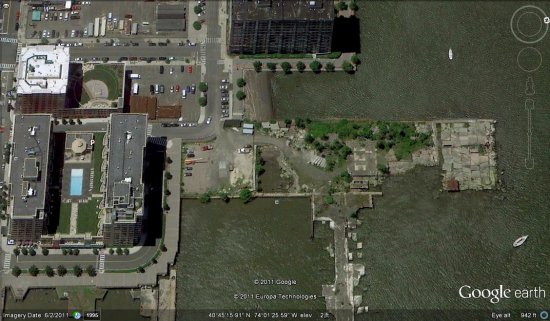On December 2, 2011, the New Jersey Department of Environmental Protection (NJDEP) issued a waterfront permit to the Shipyard Associates to build two eleven-story residential towers on a pier, thus subverting a condition of its August 1997 permit requiring the restoration of this pier as open space, accessible to the public. The original permit states that the developers must make improvements to this pier, including tennis courts and a tennis pavilion, within two years of completing the final development of the 1160-unit Shipyard development at the northeast portion of Hoboken’s waterfront. The final phase of the Shipyard project was completed more than a year ago.
In issuing this new permit, the NJDEP also disregarded several important provisions of its Coastal Zone Management regulations. The regulations require that open space be provided at both the waterward and landward end of the pier. For this project, based on the average building height proposed, the requirement would be 45 feet of open space at the end of the pier for the full width. Yet the developers have only provided 16 feet, falling far short of the requirement. The state regulations also allow housing to be built on piers only where sound pilings currently exist, yet this pier is in serious disrepair and the Hoboken Planning Board engineer and a former NJDEP employee who serves on the Hudson River Waterfront Conservancy both wrote to the NJDEP stating that the piles for this pier are unlikely to be structurally sound.
The project, dubbed the Monarch, has been unpopular from the start. The Fund for a Better Waterfront (FBW) wrote to the NJDEP in June 2011 objecting to the proposal. Mayor Dawn Zimmer and her administration also announced their opposition at that time. In October, the Hoboken City Council followed suit after residents of the Hudson TEA building, living adjacent to the site, packed the Council chambers. The Hudson River Waterfront Conservancy, a nonprofit organization that oversees the implementation of the state-mandated public walkway, has voiced its objections to the NJDEP. Recently, Assemblyman Ruben Ramos publicly denounced the NJDEP for granting the December 2 permit.
FBW is consulting with its attorneys and other organizations concerning an appeal of this permit. Mayor Zimmer is conferring with the City’s Corporate Counsel about an appeal as well. In addition to the problems stated above there are a number of other sections of the state’s Coastal Zone Management regulations that have been disregarded such the section on high-rise structures that stipulates, “The proposed structure must not block views . . . that are currently enjoyed from existing residents, roads, or pathways to the maximum extent possible .” The newly constructed Hudson River Waterfront Walkway along the Weehawken Cove, soon to be open to the public, would suffer from significantly impaired views to the Hudson River and New York City skyline if these towers were to be built.
On December 2, 2011, the New Jersey Department of Environmental Protection (NJDEP) issued a waterfront permit to the Shipyard Associates to build two eleven-story residential towers on a pier, thus subverting a condition of its August 1997 permit requiring the restoration of this pier as open space, accessible to the public.
On August 25, 2011, Shipyard Associates submitted its application to the Hoboken Planning Board requesting amended site plan approval to its 1996 planned unit development. The 1996 Planning Board granted approval to build 1160 residential units, completed last year, and included this same pier, proposed for the Monarch project, as open space with tennis courts and a tennis pavilion as per the NJDEP 1997 permit. FBW and neighborhood groups are gearing up for challenging the project before the Planning Board which could begin hearings as early as January 2012.
FBW has successfully defeated a series of proposals for private development on the piers beginning in 1990 with waterfront referendum that defeated a 30-story commercial tower on Pier A and 500,000 square feet of housing on Pier C at Hoboken’s South Waterfront. Ten years ago, FBW also helped to defeat a townhouse development on a pier at the Shipyard project. FBW has contended that such projects privatize portions of the waterfront that should be secured as part of the continuous public park at the water’s edge which is now 80% built.
Related links
Shipyard’s plan to privatize pier
NJDEP 1997 permit
HPB engineer letter to NJDEP


